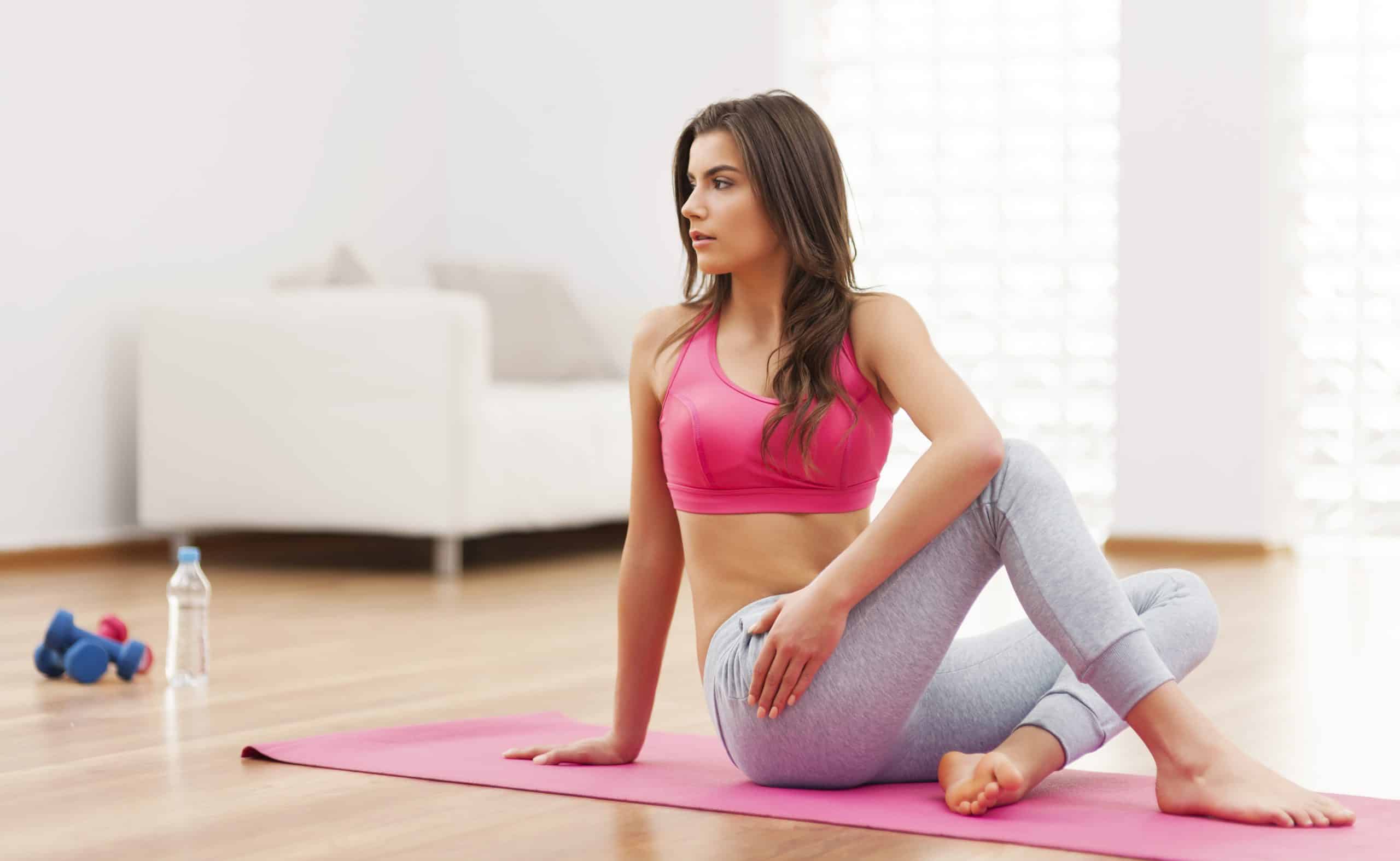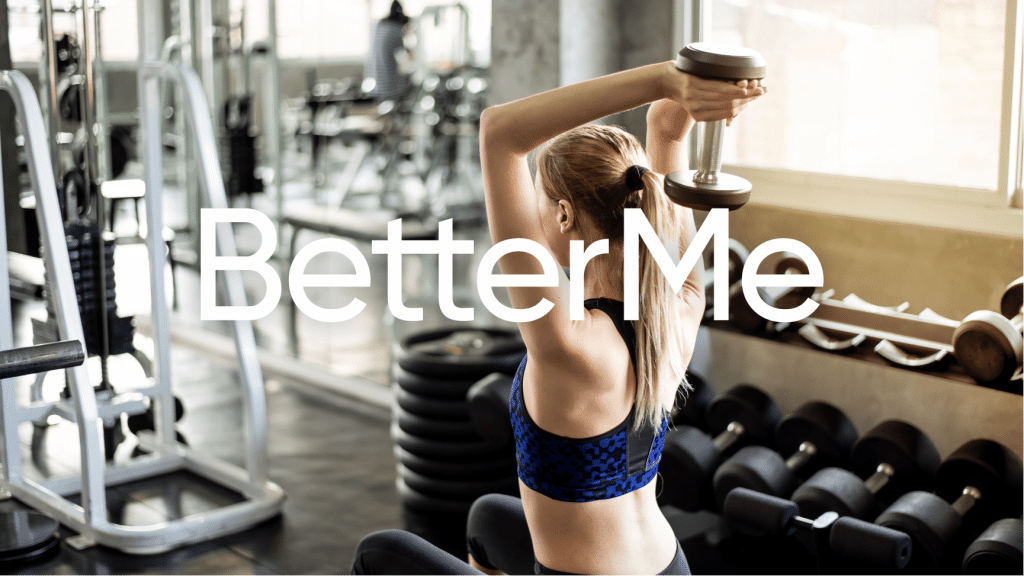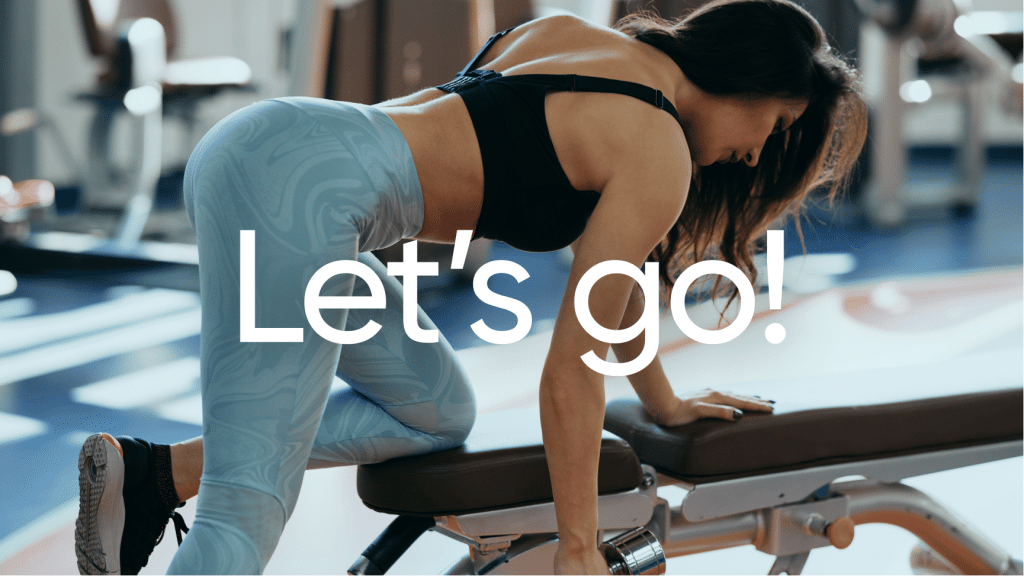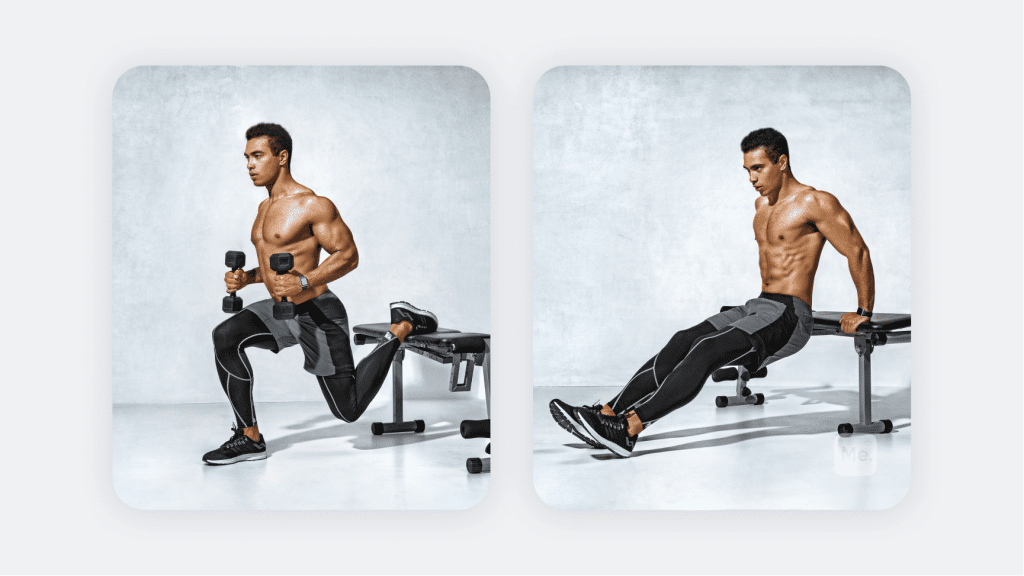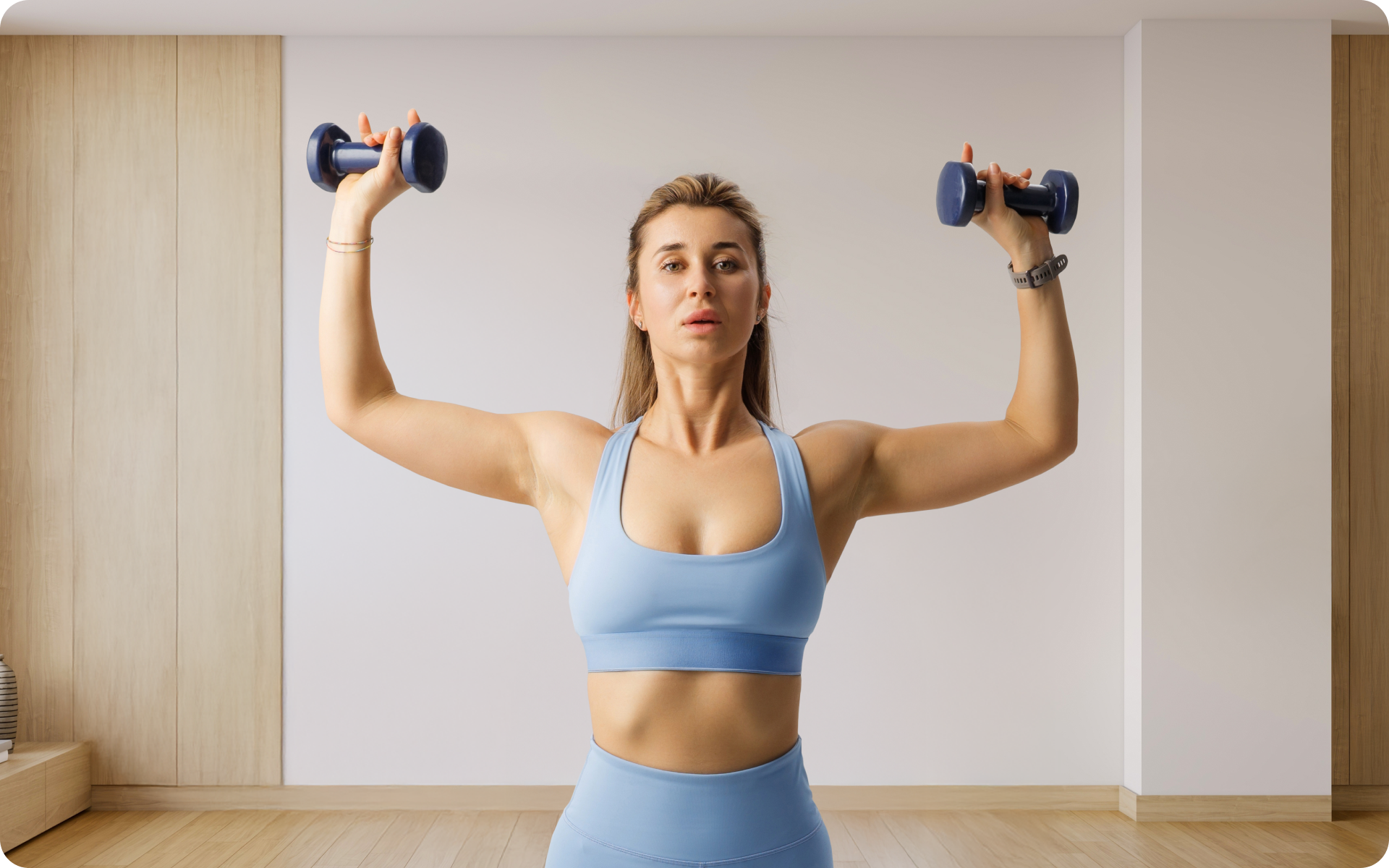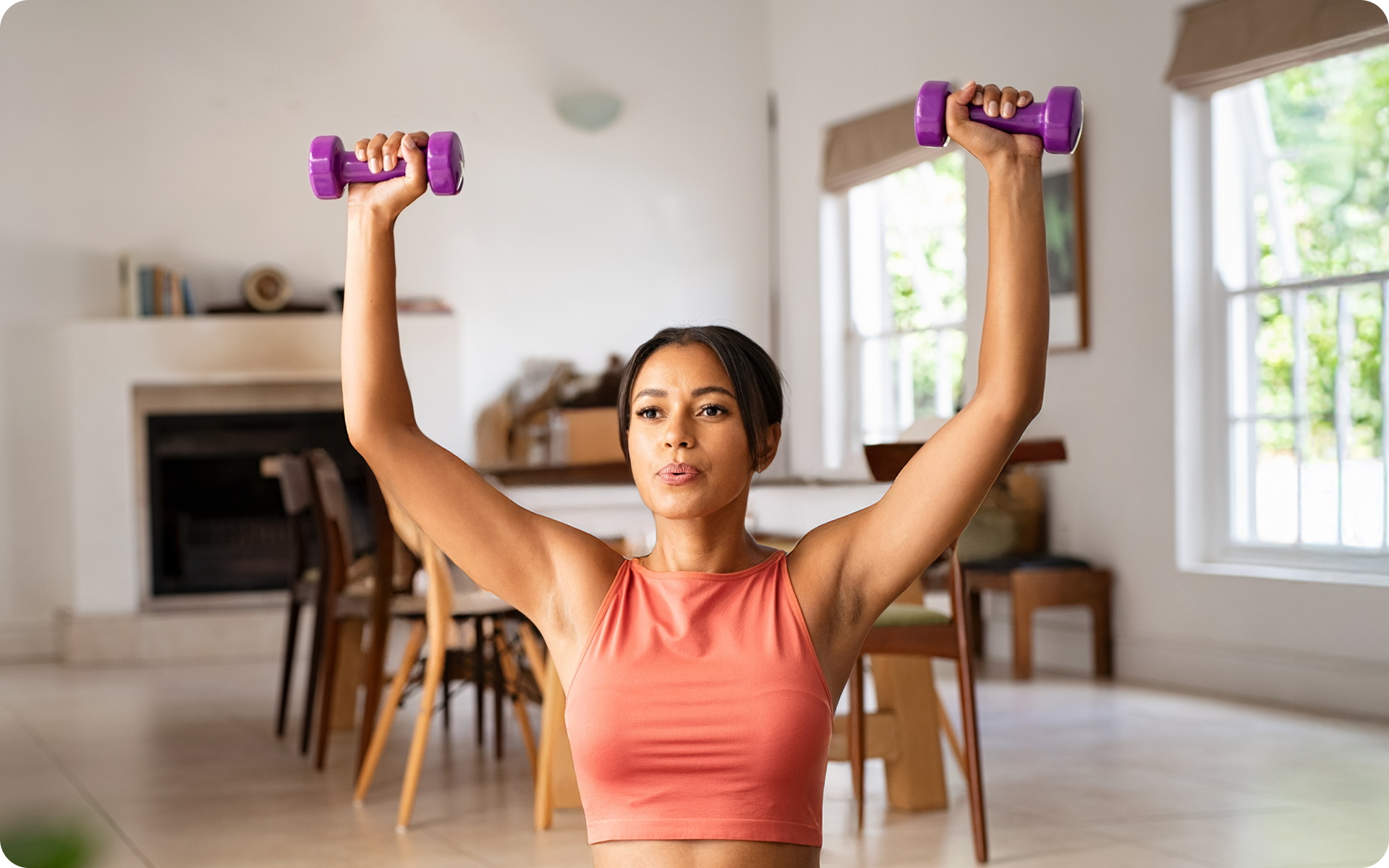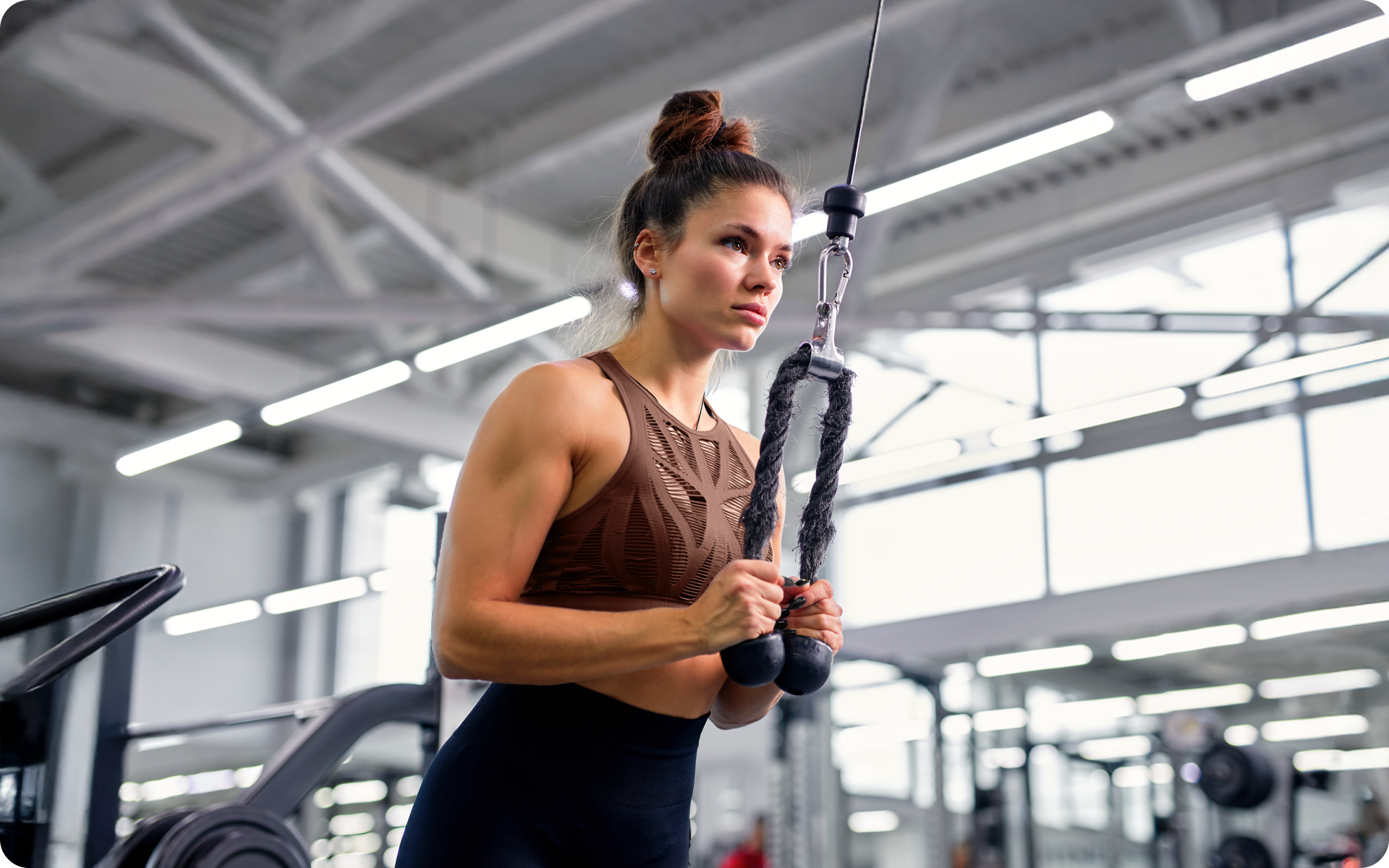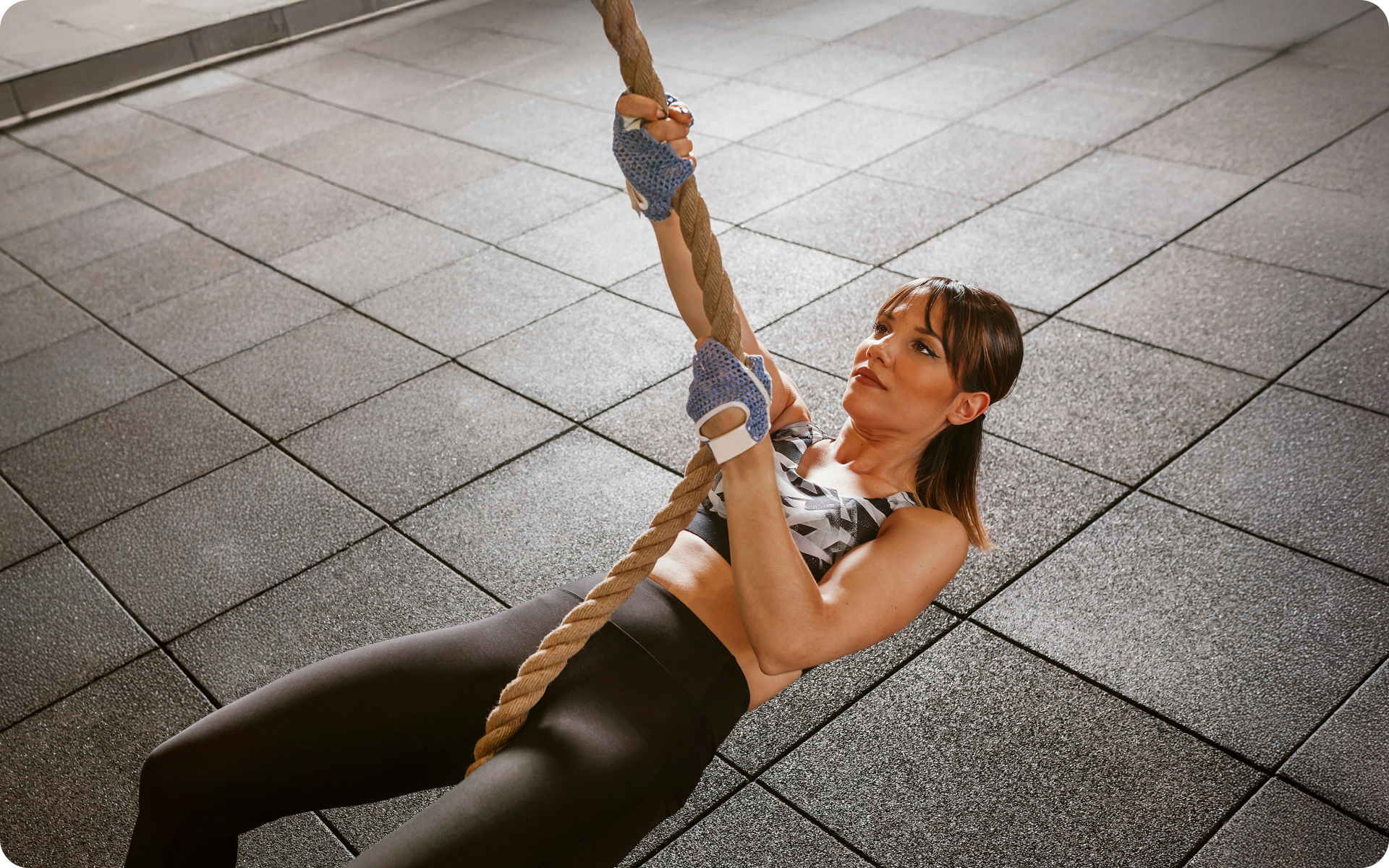Human beings have several basic movement patterns; these include pushing, pulling, squatting, hinging, rotating, and carrying. While many think of weightlifting as a way to improve their aesthetic look, the fact is that it’s also beneficial for improving these basic movement patterns. Improving these movement patterns in the gym can help strengthen your body, improve posture, and reduce risk of injury. It also improves the quality of your everyday movements, such as picking up groceries, playing with your kids, or even shoveling the driveway (1). A great way to target pushing movements is to perform a dumbbell workout that focuses on pushing exercises. Here’s what you need to know, and seven of the best dumbbell exercises for an effective push-day routine.
Get your personalized
meal plan!
What Is A Push Day Workout?
A push day workout is a type of strength training routine that focuses on pushing exercises. These exercises involve pushing weight away from the body, such as with overhead presses, chest presses, and tricep extensions.
Push days typically consist of multiple sets of each exercise with increasing amounts of weight and repetitions. The goal is to build muscle size and strength in the chest, shoulders, and triceps. These workouts are also designed to help improve balance between the pushing muscles and their opposing muscle groups—the back and biceps.
This helps to create a more balanced physique while preventing overuse injuries. Additionally, push day workouts can be used to target specific areas of the body. For example, plyometric exercises such as clapping push-ups can help to increase explosive power in the upper body.
Similarly, incorporating unbalanced movements and single-leg exercises into your push day routine can also help to improve overall balance and stability, while helping to prevent injuries (3).
Push day workouts are a great way for strength training enthusiasts to target specific muscles for improved strength and size. When combined with a balanced diet and regular cardio exercise, push days can help you to achieve your fitness goals in an efficient manner.
Note that a push day workout can be either part of a full-body routine or incorporated into body-part splits. That’s because both upper and lower body muscles are involved in a pushing motion. For example, when you want to stand up from a seated position, you are using your lower body muscles to push yourself off the seat.
When you’re pushing a door open, you’re using your upper body muscles to do the work. This demonstrates how pushing exercises can be used as a full-body or split routine depending on your goals.
Ultimately, a push day workout is an effective way to target specific muscles for improved strength and size. When combined with proper nutrition and cardio.
Read More: Boxing Techniques: 10 Moves Every Fighter Should Master For An Effective Workout
What Muscles Does Push Day Dumbbell Workout Work?
Push day typically works all muscles that involve pushing motions, either in the upper or lower body, or both. Below are some of the muscle groups that are typically targeted on a push day:
Upper Body:
- Chest: The chest muscles, or pectoral muscles, are responsible for the pushing motions of your arms. Push day involves chest exercises like bench press and push-ups to target these muscles.
- Shoulders: The shoulder muscles, specifically the front and side deltoids, are responsible for shoulder abduction and flexion. Push day includes shoulder exercises like overhead press, lateral raises, and front raises to work these muscles.
- Arms: The arms have muscles that work in opposing motions to one another, meaning when one muscle is working, the other is relaxing. The triceps are the push muscles of the arms and are targeted with exercises such as dips, triceps pushdowns, and close-grip bench press.
Lower Body:
- Quads: Your quads, or quadriceps muscles, are the main muscles that are used for knee extension, which is the pushing motion most commonly associated with leg exercises. Push day may include squats and lunges to target the quads.
- Glutes: The glute muscles are responsible for hip extension and abduction, which are important movements for many exercises. Push day typically includes exercises like glute bridges, hip thrusts, and kickbacks to target the glutes.
- Calves: The calf muscles are responsible for dorsiflexion, or when you point your toes towards your shin. Push day can include standing calf raises to work these muscles.
How Many Exercises Push Day Dumbbell Workout?
The exact number of exercises and the amount of weight you should lift on your push day dumbbell workout will depend on your individual fitness level. The general recommendation is to include 4-8 exercises per workout.
These must be a combination of multi-joint exercises, such as chest presses, shoulder presses, and rows; and single joint exercises, such as bicep curls and tricep extensions.
With that in mind, the following factors can help you decide the number and types of exercises you want to include in your push day dumbbell workout:
- Your fitness level – Beginners should opt for lower weights and fewer exercises, while more experienced lifters can increase the weight and number of exercises.
- Time – If you have a limited time to work out, you may need to focus on quality rather than quantity, which means fewer exercises taking the time to correctly target each muscle through the full range of motion. You may also want to incorporate supersets, or pairing two exercises back-to-back with minimal rest
- Muscle balance – Make sure you are evenly focusing on all of the muscle groups in your upper and lower body that are involved in a push day dumbbell workout.
- Goals – If you are looking to increase muscle size, you can perform more reps and sets of each exercise. You might perform fewer exercises, else you’ll spend hours in the gym. If you are looking to increase strength, heavier weights and fewer reps per set should be your focus. You can get away with more exercises, but be careful not to overtrain.
- Variety – Adding variety to your dumbbell workout is a great way to keep things interesting and increase motivation. That means you must have a couple of different types of exercises to choose from for each muscle group.
Reasons why BetterMe is a safe bet: a wide range of calorie-blasting workouts, finger-licking recipes, 24/7 support, challenges that’ll keep you on your best game, and that just scratches the surface! Start using our app and watch the magic happen.
How Many Push Days A Week?
The frequency of push days largely depends on your individual fitness goals. Generally, an average person should aim to have one or three push days a week (2). If you are a beginner, it is recommended to keep your workouts light and focus on form rather than intensity.
This means that one to two push days a week may be sufficient. At this fitness level, you’re at a higher risk of injury as you might not have mastered form and overtraining as your muscles may still be adjusting.
On the other hand, if you are looking to make serious gains or break through a plateau in strength and muscle growth, two to three push days a week is recommended. As you become more experienced and comfortable with the movements, your intensity can increase in order to push yourself harder.
What Is The Best Push Day Dumbbell Workout?
Ultimately, the best push day dumbbell workout is one that works for you and meets your individual fitness goals.
Here’s an example of an upper-body push day dumbbell workout:
Chest Press (3 sets of 6-8 reps)
- Lie on a flat bench with your feet flat on the floor, holding a pair of dumbbells at chest height.
- Using your chest muscles, press the dumbbells upward until they are almost touching. Make sure to keep your elbows close to your body during the movement.
- After a brief pause, lower the dumbbells back to the starting position.
Pushups (3 sets of 10-12 reps)
- Start in a high plank position with your toes planted firmly on the floor and your hands slightly wider than your shoulders.
- Lower your body towards the ground until your chest or chin touches the floor, then push yourself back up to the starting position.
- If this is too difficult, you can do incline pushups on a bench or decline pushups against a wall. To do incline pushups, place your hands on the edge of a bench and keep your feet planted firmly on the floor. Follow the steps above.
To do decline pushups:
- Place your feet against a wall and keep your hands planted firmly on the ground. Follow the steps above.
- To increase difficulty, you can do a plyometric push up by pushing off the ground explosively when your chest is close to the floor.
Overhead Press (3 sets of 6-8 reps)
- Stand up with your feet hip width apart, holding a pair of dumbbells at shoulder height. Your palms should be facing forward.
- Push the dumbbells up and over your head until your arms are fully extended. Keep your core tight and your back straight throughout the movement.
- Slowly lower the dumbbells back to shoulder height.
Read More: Meet Your Goals With Two A Day Workout Plans
Shoulder Shrugs (3 sets of 10-15 reps)
- Stand up with your feet hip width apart, holding a pair of dumbbells at your sides. Your palms should be facing inwards.
- Slowly lift your shoulders up towards your ears, then lower them back down to the starting position.
- Keep your arms straight throughout the movement and focus on using your shoulder muscles to move the weights.
Triceps Dip (3 sets of 8-10 reps)
- Sit on the edge of a bench and grip the sides with your hands, just above your hips. Place your feet flat on the floor, with your knees bent at a 90-degree angle.
- Push up with your arms to lift your body off the bench. Using your triceps, slowly lower your body until your arms are bent at a 90-degree angle.
- Pause for a moment, then push up to the starting position.
Here’s an example of a lower-body push day dumbbell workout:
Goblet Squat (3 sets of 8-10 reps)
- Stand with your feet wider than hip distance apart, holding a single dumbbell at your chest.
- Lower yourself into a squat position until your thighs are parallel to the floor. Make sure to keep your weight in your heels and your chest up, then press back up to the starting position.
- Forward Lunge (3 sets of 8-10 reps on each leg)
- Stand with your feet hip width apart, holding a pair of dumbbells at your sides.
- Step forward with one foot and lower yourself into a lunge position until your back knee is almost touching the ground.
- Push off your front leg and return to the starting position. Repeat on the other side.
Step-Ups (3 sets of 8-10 reps on each leg)
- Stand in front of a bench or box, holding a pair of dumbbells at your sides.
- Step up onto the box with one foot, pressing through your heel to bring yourself up to standing position. Step back down to the starting position.
- Repeat on the other side.
Bulgarian Split Squat (3 sets of 8-10 reps on each leg)
- Stand a few feet away from a bench or box with your back facing it. Place one foot on the bench behind you, with your toes facing up and your heel flat on the edge of the bench.
- Holding a pair of dumbbells at your sides, lower yourself into a lunge position. Your front knee should be bent at a 90-degree angle and your back leg should be straight behind you.
- Push yourself back up to the starting position and repeat on the other side.
BetterMe app will provide you with a host of fat-frying fitness routines that’ll scare the extra pounds away and turn your body into a masterpiece! Get your life moving in the right direction with BetterMe!
Calf Raises (3 sets of 10-15 reps)
- Stand with your feet hip width apart, holding a pair of dumbbells at your sides.
- Raise your heels off the ground, engaging your calf muscles. Squeeze for a moment at the top of the movement, then slowly lower back to the starting position.
- Repeat for the desired number of reps.
Good Mornings (3 sets of 8-10 reps)
- Stand with your feet hip width apart, holding a single dumbbell at the back of your neck.
- Bend forwards at the hips until your chest is parallel to the floor. Push back up to the starting position, maintaining a tight core throughout the movement.
- Pause for a moment at the top before beginning your next rep.
The Bottom Line
A push day dumbbell workout is a great way to target specific muscle groups and build strength. With the right exercises, you can build a full-body routine that will help you reach your fitness goals. Don’t forget to include a few minutes of stretching before and after each session for optimal performance and recovery.
DISCLAIMER:
This article is intended for general informational purposes only and does not serve to address individual circumstances. It is not a substitute for professional advice or help and should not be relied on for making any kind of decision-making. Any action taken as a direct or indirect result of the information in this article is entirely at your own risk and is your sole responsibility.
BetterMe, its content staff, and its medical advisors accept no responsibility for inaccuracies, errors, misstatements, inconsistencies, or omissions and specifically disclaim any liability, loss or risk, personal, professional or otherwise, which may be incurred as a consequence, directly or indirectly, of the use and/or application of any content.
You should always seek the advice of your physician or other qualified health provider with any questions you may have regarding a medical condition or your specific situation. Never disregard professional medical advice or delay seeking it because of BetterMe content. If you suspect or think you may have a medical emergency, call your doctor.
SOURCES:
- Four Types of Exercise Can Improve Your Health and Physical Ability (2021, nih.gov)
- How Much Activity Do You Need? (2019, nih.gov)
- Injury Prevention, Safe Training Techniques, Rehabilitation, and Return to Sport in Trail Runners (2022, nih.gov)
